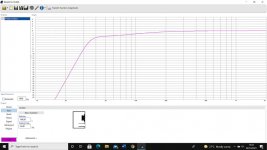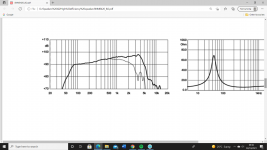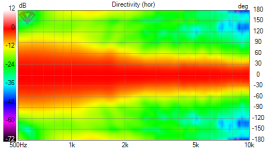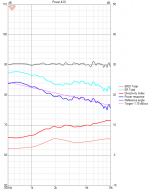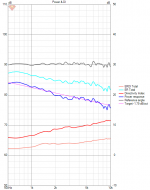Hi all
I'm in the planning stages of this 3 way build
Woofer: Faitalpro 15FH500 8 , Mid: 18 Sound 8NMB420 8, CD: 1 inch Faital HF108R. Horn: Faital STH100.
I am aiming for high efficiency even though I really don't need it. I am chasing the fabled dynamics and detail that I believe these systems can give. And I miss the sound of a large woofer (had many years ago) 🙂
woofer volume: 140L net. Mid cabinet volume: around 18 L net, for closed box Q of about 0.54 Tweeter should be good to cross over around 1500 to 1800Hz I think.
Question. I am looking at the off axis response of the Mid and the horn response. from the Faitalpro gaphs of the STH 100 its a bit difficult to see exactly were the -6db point is. The -6db point of the 18 sound 8nmb420 seems to be around 1800. so I am trying to match these. Is this the correct approach? which graphs should I be looking at please
I'm in the planning stages of this 3 way build
Woofer: Faitalpro 15FH500 8 , Mid: 18 Sound 8NMB420 8, CD: 1 inch Faital HF108R. Horn: Faital STH100.
I am aiming for high efficiency even though I really don't need it. I am chasing the fabled dynamics and detail that I believe these systems can give. And I miss the sound of a large woofer (had many years ago) 🙂
woofer volume: 140L net. Mid cabinet volume: around 18 L net, for closed box Q of about 0.54 Tweeter should be good to cross over around 1500 to 1800Hz I think.
Question. I am looking at the off axis response of the Mid and the horn response. from the Faitalpro gaphs of the STH 100 its a bit difficult to see exactly were the -6db point is. The -6db point of the 18 sound 8nmb420 seems to be around 1800. so I am trying to match these. Is this the correct approach? which graphs should I be looking at please
Attachments
Hi, the pattern control of STH100 collapses higher in frequency on vertical than horizontal axis. You'll find best xo frequency in simulator after you have built and measured the speaker.
That said the STH100 and 8" have been working nicely. I think the xo has been close to 2000Hz on all my prosotypes with quite good patterns match.
That said the STH100 and 8" have been working nicely. I think the xo has been close to 2000Hz on all my prosotypes with quite good patterns match.
I guess I will need to measure manually then. As long as the mid and the Horn are compatable is what I was concerned about. I was hoping to cross lower than 2k to avoid a too narrow dispersion. Tmuikku, You sound as though you have used this horn yourself with an 8 inch Mid. Did you try a lower Xo first?
Also what simulator is there for this. Sounds quite useful.
Also what simulator is there for this. Sounds quite useful.
You might not get all the info from a simulator, but looking at the factory beamwidth plots suggest that you begin to compromise if you go below 4k or 5k. If it wasn't for the vertical being narrow, that might come down to 3k.
Maybe you can make 2k work, if you look at the bigger picture and work carefully.
Maybe you can make 2k work, if you look at the bigger picture and work carefully.
So Allen B are you saying that this horns performance is not ideal with virtical dispersion? This is the first time I have thought about using CD and horns. so do you, or anybody know of a better horn to use? 😕
I'm not really saying that, everything has an optimum range and I'm just trying to point those out.
If you're interested in how a narrow vertical might affect a crossover point - When to use an asymmetric waveguide
If you're interested in how a narrow vertical might affect a crossover point - When to use an asymmetric waveguide
Yes it works fine with 8" driver, the dispersion is narrow but seamless transition to 8" is possible. If you want wider dispersion you should choose bigger waveguide with 90 or 100 nominal dispersion and xo lower, for 8" mid. That said, I coudn't get as smooth transition to RCF H100 horn as with STH100.
By simulator I ment if you measure the speaker 360 both horizontally and vertically, you see exactly what the acoustic output is to various directions. I'm not sure how else you could get such precise information on the actual physical object you have built. other than hire professional acoustic lab do it for you. It is matter of tweaking the xo point to get smoothest transition between the two. I had wide baffle, where the ~2kHz worked best as well as no baffle at all and same thing. It is about size of the radiators mostly what xo works.
By simulator I ment if you measure the speaker 360 both horizontally and vertically, you see exactly what the acoustic output is to various directions. I'm not sure how else you could get such precise information on the actual physical object you have built. other than hire professional acoustic lab do it for you. It is matter of tweaking the xo point to get smoothest transition between the two. I had wide baffle, where the ~2kHz worked best as well as no baffle at all and same thing. It is about size of the radiators mostly what xo works.
I'm not really saying that, everything has an optimum range and I'm just trying to point those out.
If you're interested in how a narrow vertical might affect a crossover point - When to use an asymmetric waveguide
Thanks Allen for the link. it seems I have some learning to do about horns. I might look at symmetric horns. It sounds like they would be more suitable for my purpose.
I like and use the STH100 horn and HF111 CD crossed over at 2khz. This CD/Horn sounds really nice to my ears.
I like the faster narrowing of the vertical axis than the horizontal, there is less bouncing off the floor and ceiling.
I much prefer using a cone mid-range to all the shouting that horns do
Thanks DT
I like the faster narrowing of the vertical axis than the horizontal, there is less bouncing off the floor and ceiling.
I much prefer using a cone mid-range to all the shouting that horns do
Thanks DT
Yeah there is nothing wrong in the STH100 with 8" woofer as such. xo at 2kHz is bad only if the woofer has some severe break up going on which would benefit lowering the xo frequency. Otherwise only thing that matters is the pattern match around xo which affects the off-axis response, most compression drivers are fine with lower xo frequency. The 8nmb420 seems to have very nice looking graphs at least, I think the STH100 would work just fine. It is not constant directivity device, but the directivity is smooth and transition to 8" driver is seamless especially with increased c-c (relates to AllenB linked thread, about asymmetric devices ).
I'm not sure what off-the-shelf waveguide would be better for this kind of system, my experience is only with STH100 and H100. Better is always better so keep us posted!🙂
edit:
I've been preaching too much on the center to center distance (c-c) at crossover wl lately but here is another because it relates to the statement that seamless transition between STH100 and 8" is possible. The seamless transition to woofer happens in the horizontal plane with xo roughly at 2kHz. In the vertical plane the DI is affected by the interference between the two drivers which the distance between them in relation to xo frequency defines. When the c-c is increased from "as close as possible" physical position to something more, the DI is smoothed and early reflections as well because the first early reflection point in the ceiling and floor have the xo off-axis null or not.
Attachments are,
1. normalized horizontal polars between 8" at 2kHz with with no baffle (as small as possible) and STH100 freestanding on top. The horizontal pattern is not related to the c-c, only to xo frequency. One can make xo somewhat lower and the horizontal polars stay pretty good still.
2. DI, early reflections DI and power when c-c is as close as possible (around 15cm).
3. c-c is increased to ~25cm and the vertical interference is "bettered" to make very smooth transition, almost no hump at all around xo frequency on the transition between the woofer and waveguide. These graphs include effects of both horizontal and vertical off-axis response, horizontal didn't change much with c-c so the "improvement" is due to "better" vertical off-axis response.
If xo was lowered, the vertical interference would change as well as the horizontal. Lowering xo would require even more increasing in the c-c to smoothen the hump in early reflections DI.
All these graphs could be nicer if there was no diffraction, in other words better acoustical properties on the wooferbox and better waveguide. Still, the STH100 is pretty good already.
I'm not sure what off-the-shelf waveguide would be better for this kind of system, my experience is only with STH100 and H100. Better is always better so keep us posted!🙂
edit:
I've been preaching too much on the center to center distance (c-c) at crossover wl lately but here is another because it relates to the statement that seamless transition between STH100 and 8" is possible. The seamless transition to woofer happens in the horizontal plane with xo roughly at 2kHz. In the vertical plane the DI is affected by the interference between the two drivers which the distance between them in relation to xo frequency defines. When the c-c is increased from "as close as possible" physical position to something more, the DI is smoothed and early reflections as well because the first early reflection point in the ceiling and floor have the xo off-axis null or not.
Attachments are,
1. normalized horizontal polars between 8" at 2kHz with with no baffle (as small as possible) and STH100 freestanding on top. The horizontal pattern is not related to the c-c, only to xo frequency. One can make xo somewhat lower and the horizontal polars stay pretty good still.
2. DI, early reflections DI and power when c-c is as close as possible (around 15cm).
3. c-c is increased to ~25cm and the vertical interference is "bettered" to make very smooth transition, almost no hump at all around xo frequency on the transition between the woofer and waveguide. These graphs include effects of both horizontal and vertical off-axis response, horizontal didn't change much with c-c so the "improvement" is due to "better" vertical off-axis response.
If xo was lowered, the vertical interference would change as well as the horizontal. Lowering xo would require even more increasing in the c-c to smoothen the hump in early reflections DI.
All these graphs could be nicer if there was no diffraction, in other words better acoustical properties on the wooferbox and better waveguide. Still, the STH100 is pretty good already.
Attachments
Last edited:
No, I think you are talking about something different.especially with increased c-c (relates to AllenB linked thread, about asymmetric devices ).
I can see that someone told you about spacing, you should try it..
I like and use the STH100 horn and HF111 CD crossed over at 2khz. This CD/Horn sounds really nice to my ears.
I like the faster narrowing of the vertical axis than the horizontal, there is less bouncing off the floor and ceiling.
I much prefer using a cone mid-range to all the shouting that horns do
Thanks DT
Thanks for that Dual Triode, encouraging remarks. My listening room has a lot of reflective surfaces. (less than previously though) so I am eagerly anticipating the lack of early reflections due to the directivity of horns. My hearing only goes as high as 12K these days so what ever happens higher than that doesnt matter to me so much. but the 2k area is definatly a concern.
Ok, Thanks Tmuikku and AllenB. so if I found a round horn or just one with a similar horizontal to virtical dispersion pattern (and depth of about 86mm) increased the c to c spacing to say 25cm , and made rounded baffle edges. (baffle will be 46 cm wide) it will likely suffer less problems?
I was not agreeing with tmuikku's discussion of the c-c concept.
Perhaps you could ask about sizes and shapes on this thread, explain you want to match an 8" woofer - Acoustic Horn Design – The Easy Way (Ath4)
Perhaps you could ask about sizes and shapes on this thread, explain you want to match an 8" woofer - Acoustic Horn Design – The Easy Way (Ath4)
AllenB sorry I don't understand what you refer to(#11)? what should I try, the c-c? Thats I've been using recently on a prototype but haven't done a test comparing side by side with less and more. Both sound fine in my setup but to find out which one is better a listening test would be required.
I thought to illustrate that there usually is no reason to use asymmetric device where you point in the other thread as well. Point was, being asymmetric device (STH100) still works very well with 8" so there is no need to look for anything else because it doesn't work. It works fine, but of course something else could potentially work better.
Tarl, you can use symmetric or asymmetric horn. Even though you used narrow vertical dispersion horn it doesn't mean the vertical reflections are out completely, it just makes them less in relation to direct sound. 60 degree nominal dispersion means the sound is -6db at 30 degrees off-axis, which could be your first reflection point on the ceiling. You could calculate what the angle the first reflection point is in your listening setup from the speaker height, room height and listening distance. c-c distance might affect the sound at listening position, because there could be dip in frequency response to the first reflection point but you would have to check other threads/discussion for more info about this. c-c might not be relevant at all in your situation, sorry bringing this up at this point of the thread.
Point is the STH100 works just fine, but you could use some other waveguide as well. Maybe there is something I don't understand yet why exactly axisymmetric should be always used, see the thread AllenB linked earlier there is some info to think about why. The c-c stuff has been on the mind quite recently and haven't thought about it from the symmetric/asymmetric point of view. In general you should use a horn/waveguide with least diffraction and reflections (smooth mouth roundover), but these are not off-the-shelf stuff like the STH100. More over a freestanding waveguide with roundover seems to work better in this regard than those terminated into a baffle (even with baffle roundovers). Next most important thing is to match pattern to the next device, and this is fine with the STH100 to 8" driver. So it is mostly what you feel you should use or what is easiest to source. See the acoustic horn design thread on multi-way forum for boat load of info on this, AllenB linked to that too.
Rounded baffle edges would be a very good thing, you can simulate the effect or read and think more when it is benefitical and how much is needed. Without too long a post, in general, you'd want as little as possible flat baffle around drivers for least diffraction problems. But, of course this affects baffle step and other stuff like accommodating big and small transducers on same enclosure and having enough volume inside for the bass etc. Anyway, it is quite complex system design that is behind all of this and dictate what should or could be optimized and how.
I bet you can build pretty good and fun speaker at first go without too much optimizing various stuff so go for it! You could make a quick prototype first to see how it is to build big speakers and how it sounds. If you feel there are some problems, then you could look into them more closely and think whats going on and how to better. Most often there are at least few issues to be bettered. Then, build finished pair and enjoy!
Anyway, hope it helps 🙂
^ AllenB, it is hard for me to discuss about this with you since I don't understand your point. I could then correct my knowledge and write less off if I understood what is wrong. The measured data seen on simulator is pretty obvious, I must overlook something else? Could you be more specific, thanks!
I thought to illustrate that there usually is no reason to use asymmetric device where you point in the other thread as well. Point was, being asymmetric device (STH100) still works very well with 8" so there is no need to look for anything else because it doesn't work. It works fine, but of course something else could potentially work better.
Tarl, you can use symmetric or asymmetric horn. Even though you used narrow vertical dispersion horn it doesn't mean the vertical reflections are out completely, it just makes them less in relation to direct sound. 60 degree nominal dispersion means the sound is -6db at 30 degrees off-axis, which could be your first reflection point on the ceiling. You could calculate what the angle the first reflection point is in your listening setup from the speaker height, room height and listening distance. c-c distance might affect the sound at listening position, because there could be dip in frequency response to the first reflection point but you would have to check other threads/discussion for more info about this. c-c might not be relevant at all in your situation, sorry bringing this up at this point of the thread.
Point is the STH100 works just fine, but you could use some other waveguide as well. Maybe there is something I don't understand yet why exactly axisymmetric should be always used, see the thread AllenB linked earlier there is some info to think about why. The c-c stuff has been on the mind quite recently and haven't thought about it from the symmetric/asymmetric point of view. In general you should use a horn/waveguide with least diffraction and reflections (smooth mouth roundover), but these are not off-the-shelf stuff like the STH100. More over a freestanding waveguide with roundover seems to work better in this regard than those terminated into a baffle (even with baffle roundovers). Next most important thing is to match pattern to the next device, and this is fine with the STH100 to 8" driver. So it is mostly what you feel you should use or what is easiest to source. See the acoustic horn design thread on multi-way forum for boat load of info on this, AllenB linked to that too.
Rounded baffle edges would be a very good thing, you can simulate the effect or read and think more when it is benefitical and how much is needed. Without too long a post, in general, you'd want as little as possible flat baffle around drivers for least diffraction problems. But, of course this affects baffle step and other stuff like accommodating big and small transducers on same enclosure and having enough volume inside for the bass etc. Anyway, it is quite complex system design that is behind all of this and dictate what should or could be optimized and how.
I bet you can build pretty good and fun speaker at first go without too much optimizing various stuff so go for it! You could make a quick prototype first to see how it is to build big speakers and how it sounds. If you feel there are some problems, then you could look into them more closely and think whats going on and how to better. Most often there are at least few issues to be bettered. Then, build finished pair and enjoy!
Anyway, hope it helps 🙂
^ AllenB, it is hard for me to discuss about this with you since I don't understand your point. I could then correct my knowledge and write less off if I understood what is wrong. The measured data seen on simulator is pretty obvious, I must overlook something else? Could you be more specific, thanks!
Last edited:
My gripe here is that in post #4 AllenB says the horn doesn't without explaining why. Then I show measurements and visuals from the exact device that it works and works just fine without any problems. Hence, not understanding whats the problem with here AllenB? Yes, it is not constant directivity waveguide and yes there is some diffraction since no proper mouth rollback but for what it is there is no problem with using the STH100 at 2kHz where it meets the 8" woofer dispersion perfectly. To get less diffraction and constant directivity, a different device is needed. the c-c stuff can be used to micromanage the vertical early reflections if need be, it is secondary thing to the fact that STH100 and 8" woofer mate just fine.
Back to post #3 by Tarl: the narrowing is in the waveguide (and in the woofer) dimensions not in the crossover frequency. Crossover frequency affects how the two (non coincident) transducers interfere with each other around the crossover region where both have output. The interference cause narrowing on the vertical axis in addition to what the woofer or the waveguide would do by themselves. Only thing one can do to affect the interference related narrowing is to adjust the c-c distance in relation to the crossover frequency. The narrowing happens because of c-c and crossover frequency wavelength relationship, not because of the crossover frequency or c-c alone or what the nominal dispersion of each device is. The audibility of issues due to the interference is affected by the dispersion of both transducers since the audibility is due to off-axis response which is attenuated if the dispersion is narrow. Audibility depends on the listening situation as well, what is the relationship of early reflections to direct sound and is there acoustic treatments in the room and so on.
Back to post #3 by Tarl: the narrowing is in the waveguide (and in the woofer) dimensions not in the crossover frequency. Crossover frequency affects how the two (non coincident) transducers interfere with each other around the crossover region where both have output. The interference cause narrowing on the vertical axis in addition to what the woofer or the waveguide would do by themselves. Only thing one can do to affect the interference related narrowing is to adjust the c-c distance in relation to the crossover frequency. The narrowing happens because of c-c and crossover frequency wavelength relationship, not because of the crossover frequency or c-c alone or what the nominal dispersion of each device is. The audibility of issues due to the interference is affected by the dispersion of both transducers since the audibility is due to off-axis response which is attenuated if the dispersion is narrow. Audibility depends on the listening situation as well, what is the relationship of early reflections to direct sound and is there acoustic treatments in the room and so on.
Last edited:
Tmuikku, thanks for clarifying the reason behind the vertical dispersion problems. I was about to look for a different horn with a more constant coverage, in fact still might go with a different horn. I think I will try a test baffle with 2k XO and test c-c spacing. We have lowish ceiling but carpet rug on floor. Also I found this: 18sound Xt120 horn. It's horizontal and vertical DI plots are very well matched at 2K and the Vertical dispertion seems to remains wider higher in frequency than the STH100. It's difficult to read on a mobile phone. I will have have closer look tonight on a larger screen.
Hi, yeah the xt120 might be better, I have no experience on it. I'm not sure if 90 vs 80 nominal dispersion makes much difference but of course the one is wider than the other even if it was marginal. You can find measurements of various drivers in various horns in the AudioXPress TestBench series (Google finds fast). Most of the articles have normalized polar line chart visible that gives some estimate about how the waveguides compare even though the tests are for the compression drivers. Just ignore the top octave where the (normalized) response depends on the driver as well. This kind of stuff has been discussed in the Ath thread and I assume it is true with all waveguides. At least the dispersion near xo should be comparable.
The PA waveguides / horns are relatively cheap so if you feel like it you could buy few and compare them by your own. Differences might not be too big but then you'd be certain the best alternative is used in the final build. You should be able to do this with quick scrap wood box for the mid and the waveguide freestanding on top to get a feel how they sound. You can measure them freestanding, or with some kind of mock up baffle. Or just pick one and be happy with it. Remember to have fun!😀
The PA waveguides / horns are relatively cheap so if you feel like it you could buy few and compare them by your own. Differences might not be too big but then you'd be certain the best alternative is used in the final build. You should be able to do this with quick scrap wood box for the mid and the waveguide freestanding on top to get a feel how they sound. You can measure them freestanding, or with some kind of mock up baffle. Or just pick one and be happy with it. Remember to have fun!😀
Last edited:
I used the XT120 and now the STH100, both are excellent waveguides, you don't go wrong with them to mate with a good 8" IMO. They measures and sounds really good, pick your choice. Btw, he XT120 is plastic and the STH100 is cast alu, if that matters.
Last edited:
Deni09 do you have a preference between the cast aluminium or plastic? I wonder if the plastic has less resonance?
- Home
- Loudspeakers
- Multi-Way
- Faital & 18 Sound 3 way

